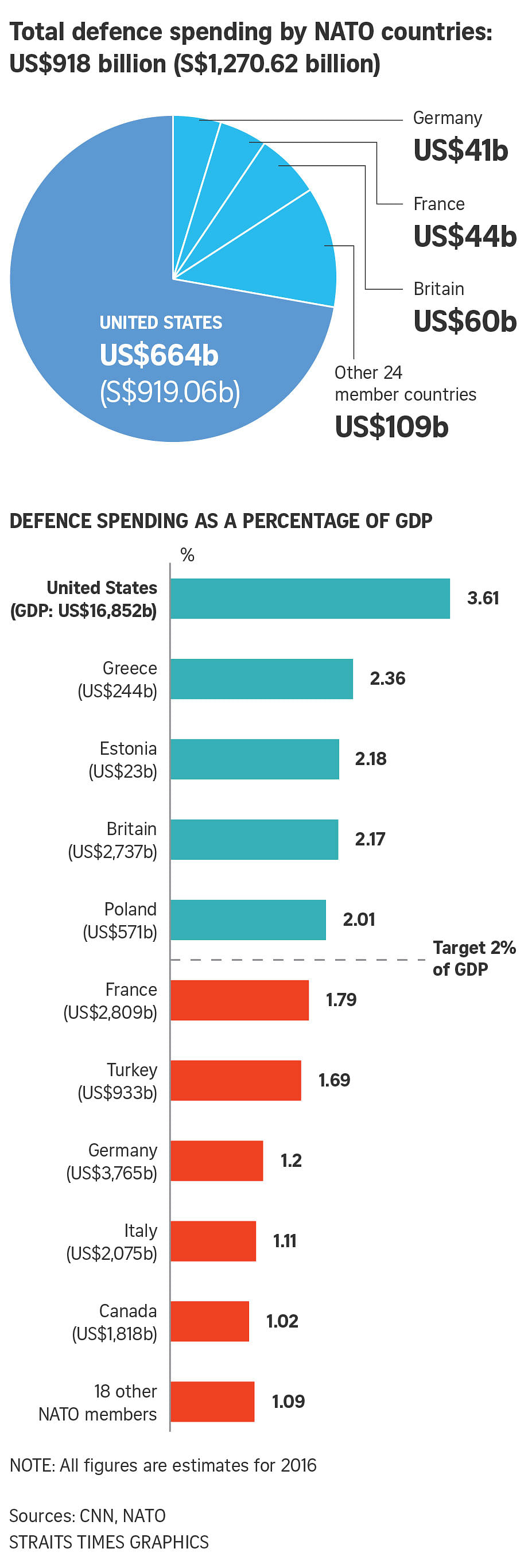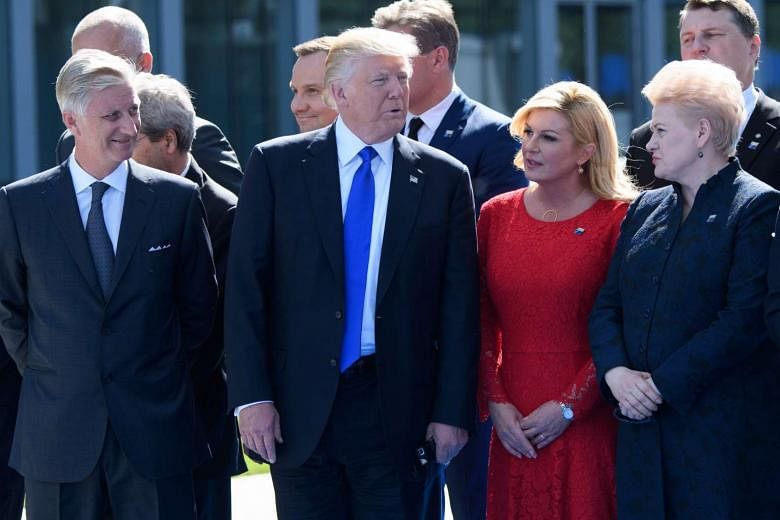BRUSSELS (NYTIMES) - President Donald Trump on Thursday (May 25) punctured any illusions that he was on a fence-mending tour of Europe, declining to explicitly endorse Nato's mutual defence pledge and lashing out at fellow members for what he called their "chronic underpayments" to the alliance.
On a tense day when Trump brought the "America first" themes of his presidential campaign to the very heart of Europe, he left European leaders visibly unsettled, with some openly lamenting divisions with the United States on trade, climate and the best way to confront Russia.
The discord was palpable even in body language. When Trump greeted Emmanuel Macron, France's new president, they grabbed each other's hands, jaws clenched, in an extended grip that turned Trump's knuckles white. When the leaders lined up to pose for the traditional photograph at Nato headquarters, Trump appeared to push aside the Montenegrin prime minister, Dusko Markovic, to get to his assigned place in the front.
The split was starkest at Nato headquarters, where Trump used the dedication of a soaring new building to lecture allies on their financial contributions. Far from robustly reaffirming Nato's mutual defence commitment in the way that many members hoped he would, Trump repeated his complaint that the United States was shouldering an unfair burden.
"Twenty-three of the 28 member nations are still not paying what they should be paying and what they're supposed to be paying for their defence," Trump declared, as the leaders shifted uncomfortably behind him, shooting one another sidelong glances.

"This is not fair to the people and taxpayers of the United States," he added. "And many of these nations owe massive amounts of money from past years and not paying in those past years."
Standing before a large piece of twisted wreckage from the World Trade Center that will serve as a memorial at the headquarters, Trump promised to "never forsake the friends that stood by our side" in the aftermath of the Sept 11 attacks - a pledge that White House officials later said was an affirmation of mutual defense.
But to European leaders, Trump's words fell far short of an explicit affirmation of NATO's Article 5 clause, the "one-for-all, all-for-one" principle that has been the foundation of the alliance since its establishment 68 years ago, after World War II.
"I think he was stingy with the US commitment and very generous with his criticisms," said Fabrice Pothier, a former head of policy planning at Nato and a senior associate at Rasmussen Global, a political consulting firm.
White House officials said Trump's message on financial contributions had galvanised Nato to confront the issue. At a closed meeting after his speech, they said, the leaders unanimously approved a resolution on burden-sharing and on fighting terrorism.
"To see unanimous support for the two main priorities of the president is a great way to start it off," said Sean Spicer, the press secretary. "When you have an entire meeting that is focused on the president's agenda, that shows the power of his message."
Publicly, though, the other leaders appeared less gratified than bewildered. During a photo-taking session, none of them spoke to Trump, except for the secretary-general of Nato, Jens Stoltenberg.
Afterwards, several surrounded Chancellor Angela Merkel of Germany, who has emerged as the strongest counterweight to the president.
Earlier in the day, Trump, a blunt critic of the European Union during his campaign, received a chilly reception from his European counterparts as they began meetings in Brussels.
His first meeting with the Continent's leaders began with officials from the United States and Europe saying nothing to each other. After being welcomed to Brussels, Trump said, "Thank you very much," but he was otherwise silent as he gazed at the cameras across the room.
Donald Tusk, who represents leaders of the bloc's 28 member states as president of the European Council, made it clear after the morning meeting that there had been several areas of disagreement.
"Some issues remained open, like climate and trade," Tusk said after the meeting at the European Union's lavish new headquarters. "And I am not 100 per cent sure that we can say today - 'we' means Mr President and myself - that we have a common position, common opinion, about Russia."
In the talks, Trump and Tusk differed over the intentions and policies of President Vladimir Putin of Russia, according to a person with direct knowledge of the meeting who spoke on the condition of anonymity because the talks were private. That reflects growing anxiety in Europe over what appear to be Russia's efforts to meddle in elections here and in the United States.
The subject of Russia did not come up in a broader meeting between US and European officials, said Michael Anton, a spokesman for the National Security Council. But Anton said he could not speak for a smaller meeting with Trump, Tusk and the president of the European Commission, Jean-Claude Juncker.
The White House put a more positive spin on the day, saying the leaders had discussed ways to deepen cooperation in fighting the Islamic State in Iraq and Syria (ISIS) and reaffirmed "the strong bond between the United States and Europe, anchored in shared values and long-standing friendship."
Climate change is another bone of contention, however. European leaders are turning up the pressure on Trump not to withdraw from the Paris climate accord that was ratified last year.
Trump's handling of Article 5 epitomises the gulf between him and other leaders. His steadfast refusal to endorse it as a candidate, and later as president, has raised fears among Nato allies about whether the United States would come to their defence in the event of an attack.
Other US officials have offered reassurances. Tillerson told reporters travelling on Air Force One this week, "Of course we support Article 5."
But until Trump speaks those words, leaders of other Nato nations seem bound to remain concerned.
Instead, Trump criticised the other leaders for not contributing 2 per cent of their countries' gross domestic product to their defence, as they have agreed to do but have often fallen short of. He even took a shot at the new headquarters, a vast glass-and-steel edifice that looks like a series of interconnected airplane hangars.
"I never asked once what the new Nato headquarters cost," Trump said. "I refuse to do so. But it looks beautiful."
In 2014, Nato members agreed to increase their military spending gradually to meet the 2 per cent of GDP goal, with 20 per cent of that spending on military equipment. Those commitments have not changed, and after remaining flat in 2015, spending increased last year among non-American alliance members.
The alarm in Europe over Trump's presidency has diminished since the days immediately after his election, in part because emissaries like Tillerson and Vice President Mike Pence have reaffirmed US support for Nato and the European Union.
But Trump, who once described Brussels as a "hellhole" overrun with radicals, remains an object of deep suspicion in the city. For some of the European leaders, testing Trump seemed to be as important as finding common ground with him.

